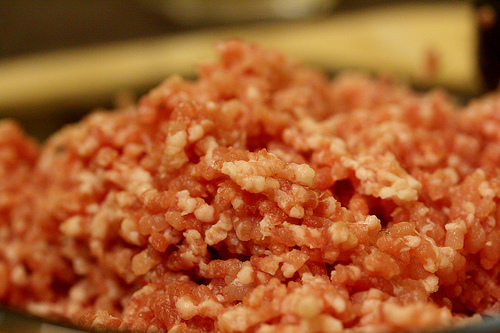What’s Yersinia doing in salad?
In 2011, an outbreak of illness caused by Yersinia enterocolitica O:9 in Norway was linked to ready-to-eat salad mix, an unusual vehicle for this pathogen.
MacDonald et al report in Emerging Infectious Diseases the outbreak illustrates the need to characterize isolates of this organism, and reinforces the need for international traceback mechanisms for fresh produce. Excerpts below.
Yersiniosis, a notifiable disease in Norway, is the fourth most common cause of acute bacterial enteritis registered by the Norwegian Surveillance System for Communicable Diseases.  Approximately 30 domestic cases are reported annually (2010 incidence rate 0.5 cases/100,000 population). In Norway, >98% of cases of Yersinia enterocolitica infection are caused by serotype O:3, which is also the dominant serotype in Europe, Japan, and parts of North America. Infection by Y. enterocolitica is often associated with ingestion of pork because pigs commonly harbor the pathogenic serotypes O:3 and O:9. Recent foodborne outbreaks have been associated with pork products (2,3) and pasteurized milk.
Approximately 30 domestic cases are reported annually (2010 incidence rate 0.5 cases/100,000 population). In Norway, >98% of cases of Yersinia enterocolitica infection are caused by serotype O:3, which is also the dominant serotype in Europe, Japan, and parts of North America. Infection by Y. enterocolitica is often associated with ingestion of pork because pigs commonly harbor the pathogenic serotypes O:3 and O:9. Recent foodborne outbreaks have been associated with pork products (2,3) and pasteurized milk.
A confirmed case-patient was defined as a person in Norway after January 1, 2011, who had laboratory-confirmed Y. enterocolitica O:9 infection that matched the MLVA profile of the outbreak strain. By May 5, the NRL had registered 21 outbreak case-patients (median age 37 years [range 10–63 years]), of whom 15 were female. Case-patients resided in 10 geographically dispersed municipalities throughout the country. Most case-patients became ill during February 7–March 20.
We traced the suspected salad mix to a single Norwegian company. Under the auspices of the Norwegian Food Safety Authority, we conducted an environmental investigation, including a traceback investigation and a review of production and cleaning procedures at the company. The suspected salad mix contained 4 salad green types: arugula, radicchio rosso, iceberg lettuce, and endive. These ingredients came, unprocessed, from 12 suppliers in 2 European countries. After delivery to the company in Norway, the greens were washed in 2 cold water baths, cut, and packaged. We found no indications of inadequate routines for ingredient control, hygiene, or sampling within Norway. We identified radicchio rosso, a leaf chicory, as the likely source of infection because it can be stored for several months and was the only ingredient included in the suspected salad mix that had delivery, production, and storage dates consistent with the outbreak period. The company in Norway traced the radicchio rosso to 1 of 3 possible growers in 1 European country but was not able to identify the source of contamination. The Norwegian company voluntarily withdrew all salad mixes containing radicchio rosso from the market. After withdrawal of the implicated ingredients, no new outbreak cases were reported.

 Yesiniosis is a gastro-intestinal disease which is notably caused by the bacterium Yersinia enterocolitica. Yersinia are predominantly spread through food, especially raw pork. Pork, for example minced pork and seasoned minced meat, is often eaten raw in Germany. One of the surprising findings of the published study was the high number of children who had eaten raw minced pork. Even of children who were one-year-old or younger it was reported that almost 30% of those who had fallen ill (and 4 % of the control persons) had eaten raw minced pork.
Yesiniosis is a gastro-intestinal disease which is notably caused by the bacterium Yersinia enterocolitica. Yersinia are predominantly spread through food, especially raw pork. Pork, for example minced pork and seasoned minced meat, is often eaten raw in Germany. One of the surprising findings of the published study was the high number of children who had eaten raw minced pork. Even of children who were one-year-old or younger it was reported that almost 30% of those who had fallen ill (and 4 % of the control persons) had eaten raw minced pork..jpg) “such meat must be cooked until the juices run clear and the meat has a whitish (poultry), gray-pink (pork) or gray-brown (beef) color. The inside temperature of the meat should be at least 70 °C for two minutes. If in doubt, consumers can measure this temperature by means of a meat thermometer.”
“such meat must be cooked until the juices run clear and the meat has a whitish (poultry), gray-pink (pork) or gray-brown (beef) color. The inside temperature of the meat should be at least 70 °C for two minutes. If in doubt, consumers can measure this temperature by means of a meat thermometer.”.jpg) further nine lettuce mixes from the market. The Norwegian Food Safety Authority recommends that consumers should not eat these lettuce mixes. The Norwegian Institute of Public Health is continuing the investigation in co-operation with the Food Safety Authority and Veterinary Institute.
further nine lettuce mixes from the market. The Norwegian Food Safety Authority recommends that consumers should not eat these lettuce mixes. The Norwegian Institute of Public Health is continuing the investigation in co-operation with the Food Safety Authority and Veterinary Institute. 